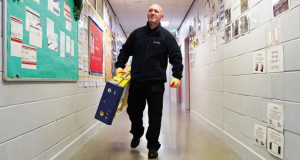
CLARE HAWKINS,
HEAD OF ENERGY SERVICES, EMCOR UK
In recent years, the carbon footprint of organisations has become a key focus, with companies striving to reduce or offset their carbon emissions where possible and move towards a carbon neutral or net zero position backed by measurable targets with deadlines.
The emergence of COVID-19 has had a significant impact on energy management – in terms of affecting the levels of energy used as buildings have been only partially occupied or shut completely; on the baselines on which targets were set as usage unexpectedly changed and on considering how the workplace will evolve as people return to work.
Energy management is an area where FM professionals can play a critical role, especially as many FM organisations have established specialist energy services divisions, with experts who can help their customers create energy management strategies and then also provide energy services to achieve their goals. Energy management forms a key part of a carbon reduction strategy and it is important for customers to understand the broad scope of energy services to realise the full benefits. Training and behavioural change programmes; purchasing options; guidance on how renewable generation can be financed without the need for capital investment and ensuring legislative compliance are just a small selection of the types of energy services available to customers from their FM provider and which can have an impact on energy consumption and costs.
In response to the COVID-19 crisis, FM professionals were able to advise companies on how they could reduce waste and carbon emissions while ensuring that their buildings remained fit for purpose. Experts could help analyse energy consumption data for customers to ensure that they were only using essential levels of energy and could create actions plans on how to make reductions and then continue to monitor and manage the on-going energy use, using SMART technology where possible.
The impact of the last 18 months has accelerated the need to reflect on the future of the workplace and to identify changes which meet employees’ new needs – such as the demand for a more hybrid way of working – while also ensuring that workplace strategies continue to deliver on sustainability goals.
As companies reconsider the future of the workplace, the emphasis on carbon footprint must remain a priority. Fewer people in offices, on-line meetings and less commuting will help reduce carbon emissions but other factors such as an increase in ventilation and the need for social distancing could adversely impact carbon performance.
Having supported organisations when workplace occupancy was dramatically reduced, the focus has now shifted to how FM providers can continue to provide strategic guidance and services which support new ways of working while also considering the long-term approach. In the race to net zero, the use of gas boilers for heating, the potential for renewable generation and the requirement to decarbonise are issues which organisations need to address and FM companies are ideally placed to advise. Through consideration of the asset management strategy and the whole life cost of a portfolio, FM professionals must develop a long-term strategy to ensure cost effective actions are prioritised to optimise carbon performance.
The FM industry has the expertise to act as consultants as well as to deliver services and, additionally, a growing number of FM organisations are making their own net zero commitments and, by doing so, will help to support their customers’ carbon reduction goals.
Everything we do has an impact on our carbon footprint and so it is critical that FM experts work in partnership with their customers and supply chain to support the UN Global goals and the Paris Agreement Treaty on climate change.

NATHAN GRAY,
HEAD OF SUSTAINABILITY, RECONOMY
One thing the pandemic has certainly done is to highlight both the fragility and resilience of the human race. We have seen how acting collaboratively can have a positive impact on global situations which seemed, at times, to be out of our control. Spending more time outside in parks, gardens and the countryside has also given many people an even greater appreciation for the natural world and our environment. My hope is that as we start to look to life after the pandemic, we will be able to harness these sentiments to bring about large scale and meaningful change.
So, what does this mean for retailers looking to re-engage their environmental and sustainability strategies? For many, waste, recycling and resource management has understandably not topped their list of priorities over the last year. Their focus has been on survival and finding ways to trade. As long as any waste they produced was collected and managed without incident, that was enough.
Things are starting to change however, and we are seeing businesses refocusing on leveraging the environmental and commercial benefits of developing a more sustainable business model for the future. This is perhaps unsurprising when you think a saving equivalent to one per cent of turnover can be brought about from waste minimisation alone. For many, a sensible starting point is to understand where they stand after these most challenging of times. The establishment of a new baseline underpinned by accurate and up-to-date data is a key part of this process. Whilst this may seem like a time-consuming exercise, there are tools, which can make life far easier.
These tools require some relatively simple waste management data in order to help evaluate an organisation’s baseline, CO2e and their climate impacts (Scope3) of their current waste services. They do this by classifying the waste management processes employed as either a positive figure (Renewable – reuse and recycling) or negative (Non-Renewable landfill / energy from waste). The objective is to support companies in working towards Zero Waste and limiting climate change to 1.5°C by 2030.
As these tools are normalised, users are able to input and aggregate data for single or multiple sites to better understand performance over their entire estate. In doing so, they are able to identify areas of opportunity and develop a clear roadmap, with intermediary measurement points, to ensure progress.
This information can then be used to implement what we have identified as the five key steps to circularity:
- Analysing where you are
- Reviewing your processes
- Communicating change
- Collaborating with your supply chain
- Introduce innovations
We must not lose sight of the potentially devastating impacts of climate change and resource scarcity. Indeed, now is the time we should be trying to harness the heightened sense of awareness and save money. It is impossible to plan a route to any destination without first knowing where you are. Only by doing this will you be able to define and prioritise the actions that need to be taken and measure your progress over a period of time.

NICK FALCO,
PRODUCT & TECHNICAL DIRECTOR AT MECHLINE DEVELOPMENTS
Disposing of food waste generated by catering operations can be costly in terms of both transportation and landfill charges—and so a sustainable approach to minimising and managing end-of-life food, which can help organisations reduce their carbon footprint, is essential.
As the Mechline Food Waste Reduction Programme outlines, the ultimate aim has to be to prevent food waste in the first place Every catering operation will of course produce some food waste – but transporting and disposing of end-of-life food to landfill is the most costly and least environmentally friendly option. Even transporting food waste for recycling contributes to carbon emissions. Operators should always choose the best economic and environmental solution to reprocess end-of-life food for each site, factoring in numerous considerations including transportation costs, carbon emissions and pollutants.





